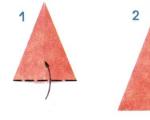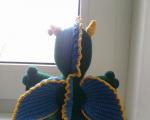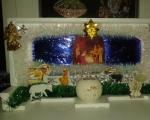Presentation for an art lesson. "Drawing with cabbage leaf
MBDOU No. 95
“The use of non-traditional drawing techniques in the visual activities of preschool children. Drawing with Chinese cabbage leaves"
Goal: to introduce teachers to the methods and techniques of non-traditional drawing techniques and their use in working with children.
Objectives: demonstration of methods and techniques for introducing children to the non-traditional technique of drawing with Chinese cabbage leaves. To encourage teachers to use non-traditional drawing techniques when working with children.
Materials: tinted paper, brushes, white and green gouache, Chinese cabbage leaves.
Stages of the master class.
Stage 1. Opening speech by the master.
Master: “Children should live in a world of beauty, games, fairy tales, music, drawing, fantasy, creativity. This world should surround the child.” (Sukhomlinsky)
In preschool age, the child’s process of cognition of the world around him has the character of emotional and practical cognition. A child of this age discovers the world around him, he is happy and surprised by his discoveries, wants to act actively, test his abilities in the practice of his own activities. Visual activity gives him such opportunities in full.
Visual activities are of great importance for the formation of a child’s personality. It develops fine motor skills and intellectual abilities of children. Thanks to it, children can reflect their impressions, convey their mood; preschoolers receive great pleasure from their actions with visual materials.
Drawing using non-traditional materials and non-standard techniques provides a unique opportunity to develop the creative abilities of preschoolers. With the assistance of an adult, they learn to think and find unusual uses for ordinary things. Techniques such as palm painting, monotype, blotography, collage develop imagination. Poking with a hard brush, various impressions, tearing paper, etc. - develop coordination of movements, eye, and fine motor skills of the hand. Children begin to experiment and create not only during direct educational activities, but also during independent activities. They come up with new ideas related to combining different drawing techniques and materials.
Non-traditional drawing techniques are effective for creating expressive images, that is, for demonstrating and developing children's talent in drawing. I decided to work in depth on the topic “Use of non-traditional drawing techniques in the visual activities of preschoolers” because it helps children successfully master visual arts and develops their creativity.
The basis for this topic was taken by R. G. Kazakova’s methodology “Drawing with preschool children: Non-traditional techniques, planning.” I selectively use methods and articles published in magazines and the Internet.
(Showing the presentation)
In my work, I use a variety of materials for drawing: stamps, dry leaves, candles, cocktail straws, cotton swabs, crumpled paper, etc. Drawing with prints of Chinese cabbage leaves aroused great interest among children. At first, the children simply painted over a cabbage leaf and printed with it. There was so much delight in the children’s eyes when they lifted the sheet and saw the image. And then we all fantasized together, what would it be like? Then the children had a desire to create a certain image.
First, the teacher needs to do preliminary work. Ask the children to imagine what time of day they would like to depict in their drawing? Depending on this, suggest thinking about what colors of paint they will use for the background? Prepare the background in any way you know. First, simply paint over a leaf of Chinese cabbage with gouache paints and print it on the leaf. Children will see for themselves what the print of the sheet reminds them of. Someone twists a sheet of paper, someone twists a cabbage leaf, someone tears off pieces of a leaf, and so on. As a result, flowers, butterflies, and fish appear.
If you print a cabbage leaf first in green and then in white on top of it, you will get a wonderful green Christmas tree!
As a result, when children get the hang of it, they will learn to control the process, draw with part of a cabbage leaf or exactly in the place where the imprint is needed according to the design of the drawing.
Stage 2. Basic.
Master: And now I want to introduce you to the methods and techniques of painting with Chinese cabbage leaves and cotton swabs. I invite 4 people to join me.
Listen to an excerpt from F. Tyutchev's poem.
Enchantress in Winter
Bewitched, the forest stands.
And under the snow fringe,
motionless, mute,
He shines with a wonderful life.
What is the poet describing in the poem? (forest)
What would you name this forest? (fabulous, enchanted, asleep)
I suggest you draw a picture for this poem.
Teachers do the work: they paint over the prepared cabbage leaves with gouache, place the cabbage leaf on a blue sheet of paper, press it hard, leaving a stamp. After everyone has stamped their leaves, the teachers complete the overall composition with snowflakes, depicting them with cotton swabs.
Stage 3. Modeling.
Master: Which of the described techniques, in your opinion, develop fine motor skills of the fingers? Do you think it is worth paying much attention to the technical side of the work or focusing on the creative component of this activity? What other non-traditional drawing techniques can be used to depict a winter landscape?
Stage 4. Reflection.
Master: And now I invite you to evaluate the master class. For this I suggest using snowflakes. A white snowflake will mean that you liked it, and you could use such drawing techniques in your work. And the red snowflake means that it was difficult or unclear for you. (Teachers’ statements, questions).
Master: Thank you for your attention. I wish you all success and good luck!

Galina Karpova
Drawing with cabbage leaf.
Well, I really liked the technique cabbage leaf drawing, which she told us about in such a way that I couldn’t help but try this wonderful technique with the children. The children were immediately captivated by this idea. First we prepared the background. Drawing wet with watercolor paints. I asked the children to imagine what time of day they wanted depict: morning, day, evening or night, besides, it suggested that the weather could be different. Perhaps it is a bright sunny morning or a cloudy day. Depending on this, she suggested thinking about what colors they would use for the background. Then still wet sheet covered it with crumpled film, pressed it down, and let it dry a little. The resulting backgrounds look something like this.


I won’t write about the technique itself; it is described in great detail on Marina Yakurina’s blog. Here are our works. Small parts completed thin brush and felt-tip pens.





But that is not all. After the lesson, an idea came to my mind, and I myself decided to make my contribution to « cabbage creativity» . If cabbage leaf turn the top upside down and print first in green, and then on top of it in white, you will get a wonderful snow-covered Christmas tree.

I tried it and it worked! Thanks again Marina!
Lesson notes for the younger group
(from 3 to 4 years)
Subject: "Walk in the winter forest"
Technique: « drawing cabbage leaf style monotype ».
Goals and objectives:
Introduce children to the methodunconventional drawing techniques – drawingcabbage leaf stylemonotype;
Summarize children's knowledge about how animals winter in the forest, what they eat, what happens to them in winter, how they prepare for winter; - be able to solve riddles, expand their vocabulary;
To form aesthetic values in childrenfeelings : the ability to see beauty in everyday life, the ability to create"beauty" with your own hands using natural materials,using the monotype method;
Cultivate interest in knowledge of nature and reflection of received ideas in artistic activities.
Equipment: Christmas trees, snowflakes, animal tracks, audio recording "Winter melody» , tinted sheet of whatman paper, white gouache, cabbage leaves, hand napkins, brushes.
Greetings "Hello"
Children enter the group to quiet music.
The teacher reads a poem :
Hello, golden sun!
Hello, the sky is blue,
Hello, free breeze,
Hello, little white snowball!
We live in the same region -
I greet you all!
The audio recording is playing "Winter melody"
Teacher: Guys, please tell me what time of year it is now?(winter) . Yes, that's right, winter has come.
– Guys, winter has brought us cold, snow, and wind. How does the wind blow in winter? (Children take a deep breath through their nose and, puffing out their cheeks, exhale forcefully in four counts, 3-4 times.)
Imitation game "Snowflakes"
– The wind brought snowflakes. They flew and spun! (The teacher offers the children"to transform" into snowflakes and fly to the music.)
– The wind subsides, snowflakes slowly fall to the ground.(Children sit or lie down on the carpet in arbitrary poses) .
– The snow covered the roads, fields, and forests with a warm blanket. And who doesn’t sleep in the forest in winter?(Children's answers.)
Teacher: I suggest you dowalk through the winter forest , and see for yourself which animals do not sleep in winter. Want to go with me? Then it's time to get ready for the road.
Playing with imaginary objects
The teacher addresses the children:
– We will put on felt boots, hats, fur coats, fasten them with all the buttons, tie scarves and be sure to put on gloves.(Children, imitating the teacher, imitate movements.)
– Now we are all dressed and we can go outside.
Simulation exercise “We are walking through snowdrifts”
We are walking through the snowdrifts,(Children walk with their legs raised high)
Through steep snowdrifts.
Raise your leg higher
Make way for others.
We walked for a very long time,
And we found ourselves in the forest.
Guys, here we are and we came to the forest. Look how beautiful it is all around! Do you know the names of the trees that grow in our forest?
Yes, that's right, these are Christmas trees.
– Guys, tell me, what else did you see in our forest clearing?(snowflakes) Well done, look how beautiful they are. There were so many of them that our clearing was covered with snow.
But what is this, guys? I see some prints in the snow. What do you think this is? That's right, these are traces. Do you know whose they are?(No) Now we will follow the trail, and together we will try to guess who left this trail.
Didactic exercise “Recognize an animal by its tracks by solving a riddle”
Oh guys, there are some envelopes here. I'm reading a riddle.
The owner of the forest, wakes up in the spring.
And in winter, under the blizzard howl
He sleeps in a snow hut. (bear)
(After each riddle, the teacher opens the envelope and shows a photo with the answer).
That's right, it's a bear. Who can tell me what his house is called?(den) . That's right, the bear has already hibernated in his den.
Look how big his tracks are. They are a little like human tracks, only the bear has long, sharp claws.
How does a bear prepare for winter?(He accumulates a lot of fat and sleeps in a den all winter) .
Let's go see whose next trail it is. I'm reading a riddle.
Jump and jump - the coward has disappeared,
This is a small... (bunny)
Yes, that's right, well done. This little bunny left his tracks.
Who wants to tell you how a hare spends the winter? (By winter, he changes his fur coat to white, hides under a bush, is afraid of everyone, eats tree branches.) Does the bunny have his own home?(no, he sleeps under a bush) .
Whose other footprints are left in the snow? I'm reading a riddle.
She is more cunning than all the animals,
She is wearing a red fur coat.
A bushy tail is her beauty.
This forest animal? (fox)
That's right, it's a fox. Look, her tracks look like a flower.
Who wants to tell you how a fox spends the winter?(Dresses in a warm fur coat, lives in a hole, hunts mice and bunnies) . Who knows what the fox's house is called?(Nora) .
Teacher:
Snowflakes swirled in the sky
And they fell on our shoulders.
There is beauty and peace all around,
Well, it's time for us to go home.
Teacher: Guys, ours has come to an end.walk through the forest, I suggest returning to the art studio and everyone togetherdraw thatwhat you and I saw in the forest, butpaintDo we agree not in the usual way, but with the help of a cabbage leaf? Then let's go:
The path snakes under your feet,
We will return home with you.
Collective drawing « Winter forest »
(explanation drawing techniques )
To begin with, put the cabbage leaf with the ribbed side up, apply white paint to it, then carefully turn the leaf over and apply it to the album sheet, pressing it well, not forgetting the edges. We remove the sheet. It turned out to be a beautiful winter tree, all that remains is to correct the trunk and branches.
You can make another tree nearby, and to diversify our forest, you can add a couple of strokes of a different paint. Guys, which paint is more suitable for a winter forest? That's right - blue, light blue.
You can also add white snowdrifts and snow. We draw snow using an ear stick using the poking method.
Teacher: Look what a wonderful picture we got, does it look like the clearing where we were?
Teacher: Did you like ourwalk through the winter forest? What do you remember about her?
How can you tell whichthe walk turned out well? (cheerful, joyful, winter )
Thank you guys for agreeing to go into the forest with me.
What's your mood now?(Good) .
Let's give our good mood to others.(Children blow the mood off their palms) .
Subject:"Winter. Winter forest.” (senior group)
Educator E.V. Gileva
Integration of educational areas:“Cognitive development”, “Social and communicative development”, “Artistic and aesthetic development”, “Physical development”, “Speech development”
Types of children's activities: gaming, communicative, musical and artistic, productive.
Target: Teaching children non-traditional drawing techniques, clarifying and generalizing children’s knowledge about winter.
Software tasks:
Educational:
-Introduce the technique - imprinting with a cabbage leaf and drawing with a cotton swab.
-Learn to press a cabbage leaf to colored paper and make an imprint on the paper;
Developmental:
-Develop creative individuality.
- Develop fine motor skills of hands.
- Contribute to the development of children's creativity when doing work independently.
. Educational:
- To cultivate in children a sense of beauty, a love for nature, for their native land through fine art, music, poetry.
- Cultivate interest in reflecting one’s impressions in visual arts.
-Cultivate accuracy when working with paints.
Technique: Drawing an imprint (imprint) with a cabbage leaf and drawing with a cotton swab.
Materials and equipment: easel, illustrations depicting a winter forest; white gouache; sheets of tinted paper, brushes; jars of water, napkins, cotton swabs; cabbage leaves, snowball with a surprise inside. Laptop, ribbons, “rain”
Enrichment and activation of the dictionary:
Ancient names of the months: gloomy, fierce, snowy;
GCD move
1. ORGANIZATIONAL MOMENT.
Educator:
All the children gathered in a circle
I am your friend and you are my friend
Let's hold hands tightly
And let's smile at each other
Let's give smiles to each other.
Educator:
I invite you to take a trip to the kingdom of winter nature...
Guys, listen to A. S. Pushkin’s poem “Winter Morning”:
Under blue skies
Magnificent carpets,
Shining, the snow lies in the sun,
The transparent forest alone turns black,
And the spruce turns green through the frost,
And the river glitters under the ice.
2. MAIN PART.
Educator:
Guys, tell me what time of year is the poem talking about? (Winter) (I post a picture of winter)
Yes, but winter, unfortunately, is ending, and I would like us today to remember winter and talk about this wonderful time of year.
Educator:
Each season has its own 3 months. Do you know the winter months? Please name it.
Children's answers:
December January February.
Educator:
Guys, do you know that in the old days, people called December “gloomy”. Why do you think? (Children's answers) Correct, because in December the sun rarely peeks through the low gray clouds, the days were gloomy and sunless.
And in the old days January was called “fierce”. Why do you think? (Children's answers). I agree with you, because the cold is fierce, the frost is crackling, and the snow is creaking underfoot. February was popularly called “snowfall”. Why? Yes, this month snowstorms and blizzards create high snowdrifts, and it is at this time that the most snow falls.
Educator:
We learned the ancient name of each winter month!
Educator:
-What games do children like to play most in winter?
Game: "Snowball"
I invite you to play in the snow, I will throw a snowball at you, and you must describe winter in one word. For example: “What winter is it like? - snowy, cold...” and threw the snowball back.
-Tell me, what kind of winter are we having?
Children's answers:
White, fluffy, silver, cold, snowy, beautiful, icy, magical, fairy-tale, frosty, blizzard, sparkling, harsh, cheerful.
Educator:
Yes, guys, you are right, our winters are indeed very different. It is both cold and thawed, with snowstorms and dripping snow, with crisp snow.
Educator:
Poets, artists, composers very often like to tell us about winter in their works. Poets - in words (poems, stories, composers - in sounds (music), artists - in colors (paintings).
Educator:
Composers in their works convey the character and mood of winter in music. I suggest you dance an impromptu dance to the music of Sviridov “Blizzard. Waltz" and create images where boys will see winter trees, and girls will see snow.
(The children are given ribbons and “rain”; the children perform an improvisation to the music of Sviridov’s “Blizzard. Waltz”. After the music ends, the children sit on chairs and put away their attributes.
Well done guys, you dance great.
3. CONSIDERATION OF ONE OF THE PICTURES.
Let's admire the paintings
How do we understand that winter is depicted?
What did the artist depict?
What color paint did the artist use?
What thoughts and desires arise in you when you look at this picture?
Guys, did you like the art gallery?
Would you like us to organize our own little gallery?
Children: YES!
Guys, we will try to convey the character and mood of winter ourselves.
Please take your seats
4. EXPLANATION BY THE TEACHER AT THE BOARD.
Look, what unusual things are on your tables? (cabbage leaf and cotton swabs).
Guys, today I want to introduce you to an unusual drawing technique. The drawing technique that I will introduce you to today is called cabbage leaf imprint and drawing with a cotton swab. See how this technique is done.
First you need to choose the more prominent, convex side of the cabbage leaf. Using a brush, apply white paint to the cabbage leaf.
We print it.
The tree is almost ready! Then we’ll draw the trunk and branches a little more expressively.
You can take several cool shades, we decided to take blue and also apply it to a cabbage leaf, it turns out very interesting.
At the end, you can draw the ground covered with snow.
And using a cotton swab, draw a snowball. First, dip a cotton swab into water, then into paint. Drawing snowflakes.
But first, let's get our fingers ready for work.
5. FINGER GYMNASTICS.
One two three four five, Bend your fingers.
You and I made a snowball. Children "sculpt".
Round, strong, very smooth They show a circle, clasp their palms, stroke one palm with the other.
And not at all sweet. They shake their fingers.
Once - we'll throw it up, "Tossed up."
Two - we'll catch "They're catching me."
Three - let's drop "They drop it."
And... we'll break it. They stomp.
N. Nishcheva
6. DOING WORK BY CHILDREN.
Guys, where do we start working? Now, guys, let's get to work and try to draw your own fairy forest. (Children work to the music “Draw”)
7. COLLECTIVE WORK.
Guys, I suggest you put all your works on the board, create your own gallery, and admire the endless winter forest.
8. ANALYSIS OF WORKS:
Who do you think got the snowiest job?
Who has the densest forest? Who has the highest snowdrifts? Who has the neatest job?
9. RESULT OF THE LESSON.
So, guys, what time of year were we talking about today? How did we draw trees? How did we depict falling snow? What new have you learned?
I would like to finish our lesson today with the famous poem by the poet Ivan Zakharovich Surikov “Winter”
White snow, fluffy,
Spinning in the air
And the ground is quiet
Falls, lies down.
And in the morning snow
The field turned white
Like a veil
Everything dressed him.
Dark forest - what's with the hat?
Covered up weird
And fell asleep under her
Strong, unstoppable...
God's days are short
The sun shines little
The frosts are here
And winter has come.
(While reading the poem, I throw the cut out snowflakes up)
Educator:
- I want a piece of our lesson to remain in your heart, and for this unusual magical snowball to please you (I open the snowball and take out candy for the children).





